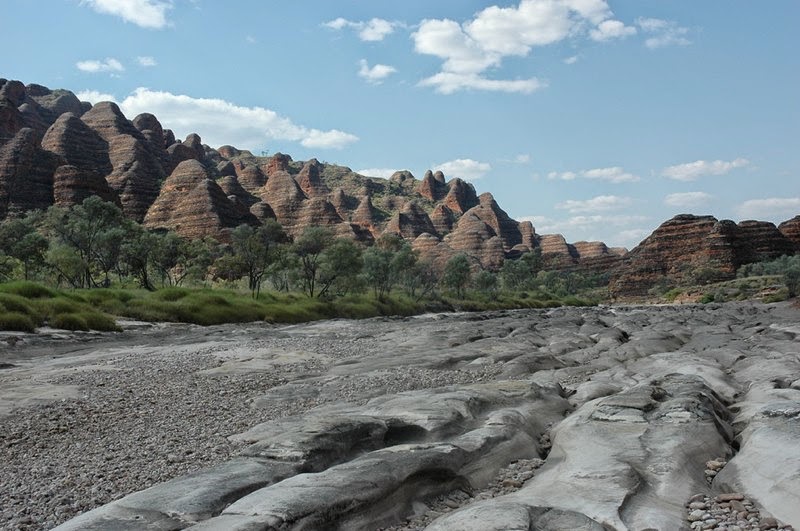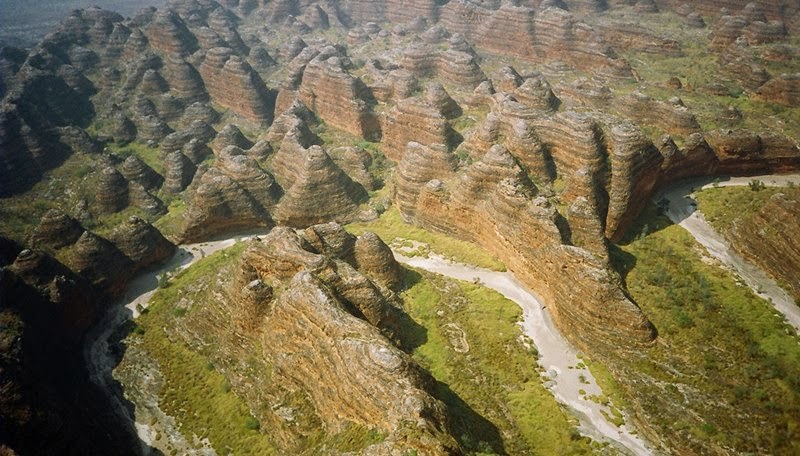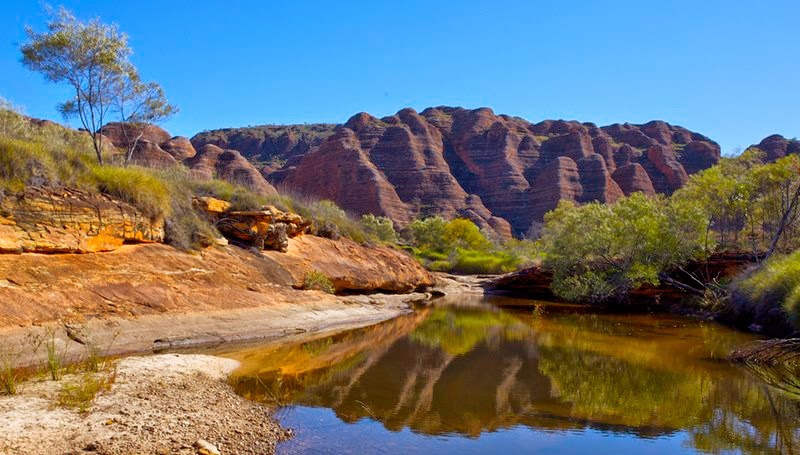Purnululu National Park is famous for its mountain range rocks Bungle Bungle range resembling the hives, western Australia. Over 20 million years, these hills of sandstone forces of nature turned into a surreal maze of orange cones, decorated with black stripes and multi-colored highlights. The name "Purnulu" in the language of the Australian aborigines means "sandstone".
 |
| Bungle Bungles |
Bungle Bungles
Unique rounded rock towers consist of a mixture of sandstone and coarse pebbles and cobbles. Striped mountain of steel due to erosion. The dark bands are more permeable to the algae that bloom on the surface, bright consist mainly of iron and manganese species that are not amenable to external influence and have a bright orange hue. Cones ghat Bungle Bungle-more like alien ships than geological formations. Some unusual shape resembles rocks spine huge prehistoric animal. Surprisingly, for a long time about this natural miracle knew only local Aboriginal tribe cues. Europeans discovered these unusual hives only in the mid-1980s.
Once over a region of flying a plane with a group of directors. After a detailed analysis of the photographs and videos obtained from surveys, unexplored land in the state of Western Australia has become known worldwide. In 1987 there was established the Purnululu National Park in 2003, included in the UNESCO World Heritage List. In the language of the tribe cue "Purnululu" means "sandstone".
Bungle Bungles Australia
The Bungle Bungles- as its original name, is a corruption of "bundle-bundle", which means "grass". During the rainy season, the Australian Aborigines cue used these unusual rocks as shelters. Not surprisingly, this rugged system consisting of gorges, ravines, cliffs, domes, and natural mountain ranges, has evolved into a real gallery of petroglyphs. In addition, here is the burial of the tribe.
Conglomerates and sandstones make up these distinctive towers with beehive shapes. These rocks are primarily composed of boulders and pebbles and then combined together with finer material. These sedimentary formations were formed in the Red Basin between 375 and 350 million years ago when active faults were changing the landscape. These domes were formed by the combined effects of wind from the Tanami Desert and rain over millions of years.
It is located in the eastern Kimberley region, on the plains bordering it. These ranges are made up of layers of dolomite and ancient seabeds. Satellite images of Bungle Bungle Ranges clearly show a circular topographic feature measuring 7 kilometers in diameter. This feature is thought to be the remnant of an ancient meteorite impact crater. It is also known as the Piccaninny Crater.
Because of differences in the layers and sandstone, the conical rock formations have an unusual orange-grey banding. The layers that hold more water have darker bands. These are dark algal and cyanobacteria growths. Iron and manganese mineral deposits are found within the sandstone, which gives these layers their orange color. An area of around 450 square kilometers covers the Bungle Bungles Range Formation.
Frist Image credit Rodney Skerman
 |
| Bungles |
Image credit RobertZw
Image credit Benjamin Jakabek
 |
| Bungle Bungle Range |
Image credit Rodney Skerman
Bungle Bungles- as its original name, is a corruption of "bundle-bundle", which means "grass"
 |
| Bungle Bungle Ranges |
 |
| Bungle Bungles Australia |
Image credit Tomas Klein
Image credit Erik Hartberg
 |
| The Bungle Bungle |
Image credit Sean Parkinson
 |
| The Bungle Bungles |
Image credit Erik Hartberg
 |
| Bungle Bungle Ranges |
Image credit Sandi1947
 |
| The Bungle Bungle |
Image credit Rodney Skerman
 |
| Bungle Bungles Australia |
Image credit Piotr Strzelecki
 |
| Bungle Bungle Ranges |
Image credit Benjamin Jakabek
 |
| Bungle Bungle Range |
Image credit Benjamin Jakabek
 |
| Bungles |
Image credit Benjamin Jakabek
Bungle Bungle map
 |
| Bungle Bungles |
Image credit mitchellh53


No comments:
Post a Comment